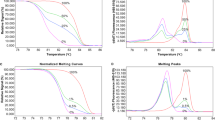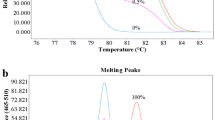Abstract
Background
The incidence of gastric cancer has long been at a high level in China, seriously affecting the health of Chinese people.
Aims
This case‒control study was performed to identify gene methylation biomarkers of gastric cancer susceptibility.
Methods
A total of 393 gastric cancer cases and 397 controls were included in this study. Gene methylation in peripheral blood leukocytes was detected by a methylation-sensitive high-resolution melting method, and the Helicobacter pylori antibody presence was semi-quantified in serum by ELISA.
Results
Individuals with total methylation of CDKN2B/P15 had a 1.883-fold (95%CI: 1.166–3.040, P = 0.010) risk of gastric cancer compared with unmethylated individuals. Individuals with both CDKN2B/P15 and NEUROG1 methylation had a higher risk of gastric cancer (OR = 2.147, 95% CI: 1.137–4.073, P = 0.019). The interaction between CDKN2B/P15 and NEUROG1 total methylation on gastric cancer risk was affected by the pattern of adjustment. In addition, the joint effects between CDKN2B/P15 total methylation and environmental factors, such as freshwater fish intake (OR = 6.403, 95% CI = 2.970–13.802, P < 0.001), irregular diet (OR = 5.186, 95% CI = 2.559–10.510, P < 0.001), unsanitary water intake (OR = 2.238, 95% CI = 1.144–4.378, P = 0.019), smoking (OR = 2.421, 95% CI = 1.456–4.026, P = 0.001), alcohol consumption(OR = 2.163, 95% CI = 1.309–3.576, P = 0.003), and garlic intake(OR = 0.373, 95% CI = 0.196–0.709, P = 0.003) on GC risk were observed, respectively. However, CDKN2B/P15 and NEUROG1 total methylation were not associated with gastric cancer prognosis.
Conclusion
CDKN2B/P15 methylation in peripheral blood may be a potential biomarker for evaluating susceptibility to gastric cancer. The joint effects between CDKN2B/P15 methylation and environmental factors may also contribute to gastric cancer susceptibility.

Similar content being viewed by others
Data availability
Not applicable.
Code availability
Not applicable.
References
Sung H et al. Global cancer statistics 2020: GLOBOCAN estimates of incidence and mortality worldwide for 36 cancers in 185 countries. CA Cancer J Clin. 2021;71:209–249.
Vogelstein B et al. Cancer genome landscapes. Science. 2013;339:1546–1558.
Padmanabhan N et al. How to stomach an epigenetic insult: the gastric cancer epigenome. Nat Rev Gastroenterol Hepatol. 2017;14:467–478.
Tahara T et al. DNA methylation as a molecular biomarker in gastric cancer. Epigenomics. 2015;7:475–486.
Esteller M. CpG island hypermethylation and tumor suppressor genes: a booming present, a brighter future. Oncogene. 2002;21:5427–5440.
Herman JG et al. Gene silencing in cancer in association with promoter hypermethylation. N Engl J Med. 2003;349:2042–2054.
List of classifications, volumes 1–123. https ://monographs.iarc.fr/list-of-class ifications-volumes/.
Teschendorff AE et al. An epigenetic signature in peripheral blood predicts active ovarian cancer. PLoS One. 2009;4:e8274.
Fraga MF et al. Epigenetic differences arise during the lifetime of monozygotic twins. Proc Natl Acad Sci U S A. 2005;102:10604–10609.
Onwuka JU et al. A panel of DNA methylation signature from peripheral blood may predict colorectal cancer susceptibility. BMC Cancer. 2020;20:692.
Barry KH et al. DNA methylation levels at chromosome 8q24 in peripheral blood are associated with 8q24 cancer susceptibility loci. Cancer Prev Res (Phila). 2014;7:1282–1292.
Wojdacz TK et al. Identification and characterization of locus-specific methylation patterns within novel loci undergoing hypermethylation during breast cancer pathogenesis. Breast Cancer Res. 2014;16:R17.
Herman JG et al. Methylation-specific PCR: a novel PCR assay for methylation status of CpG islands. Proc Natl Acad Sci U S A. 1996;93:9821–9826.
Sakata K et al. Loss of heterozygosity on the short arm of chromosome 9 without p16 gene mutation in gastric carcinomas. Jpn J Cancer Res. 1995;86:333–335.
Hebert J et al. Candidate tumor-suppressor genes MTS1 (p16INK4A) and MTS2 (p15INK4B) display frequent homozygous deletions in primary cells from T- but not from B-cell lineage acute lymphoblastic leukemias. Blood. 1994;84:4038–4044.
Herman JG et al. Hypermethylation-associated inactivation indicates a tumor suppressor role for p15INK4B. Cancer Res. 1996;56:722–727.
Toyota M et al. CpG island methylator phenotype in colorectal cancer. Proc Natl Acad Sci U S A. 1999;96:8681–8686.
Toyota M et al. Aberrant methylation in gastric cancer associated with the CpG island methylator phenotype. Cancer Res. 1999;59:5438–5442.
Wen J et al. Promoter methylation of tumor-related genes as a potential biomarker using blood samples for gastric cancer detection. Oncotarget. 2017;8:77783–77793.
Fanous AH et al. Association between the 5q31.1 gene neurogenin1 and schizophrenia. Am J Med Genet B Neuropsychiatr Genet. 2007;144B:207–214.
Herbst A et al. Methylation of NEUROG1 in serum is a sensitive marker for the detection of early colorectal cancer. Am J Gastroenterol. 2011;106:1110–1118.
Candiloro IL et al. Rapid analysis of heterogeneously methylated DNA using digital methylation-sensitive high resolution melting: application to the CDKN2B (p15) gene. Epigenetics Chromatin. 2008;1:7.
Zhou H et al. Combined effect between WT1 methylation and Helicobacter pylori infection, smoking, and alcohol consumption on the risk of gastric cancer. Helicobacter. 2019;24:e12650.
Eichelberger L et al. Risk of gastric cancer by water source: evidence from the Golestan case-control study. PLoS One. 2015;10:e0128491.
Shin CM et al. Role of Helicobacter pylori infection in aberrant DNA methylation along multistep gastric carcinogenesis. Cancer Sci. 2010;101:1337–1346.
Woo HD et al. Genome-wide profiling of normal gastric mucosa identifies helicobacter pylori- and cancer-associated DNA methylome changes. Int J Cancer. 2018;143:597–609.
Tang H et al. Diallyl disulfide suppresses proliferation and induces apoptosis in human gastric cancer through Wnt-1 signaling pathway by up-regulation of miR-200b and miR-22. Cancer Lett. 2013;340:72–81.
Cai X et al. Selenium exposure and cancer risk: an updated meta-analysis and meta-regression. Sci Rep. 2016;6:19213.
Alghanim H et al. Development of DNA methylation markers for sperm, saliva and blood identification using pyrosequencing and qPCR/HRM. Anal Biochem. 2020;611:113933.
Fujita Y et al. Analysis of clinicopathological and molecular features of crawling-type gastric adenocarcinoma. Diagn Pathol. 2020;15:111.
Wojdacz TK et al. Methylation-sensitive high resolution melting (MS-HRM): a new approach for sensitive and high-throughput assessment of methylation. Nucleic Acids Res. 2007;35:e41.
Wojdacz TK et al. Limitations and advantages of MS-HRM and bisulfite sequencing for single locus methylation studies. Expert Rev Mol Diagn. 2010;10:575–580.
Gao HL et al. Methylation status of transcriptional modulatory genes associated with colorectal cancer in northeast China. Gut Liver. 2018;12:173–182.
Liu Y et al. Multiple gene-specific DNA methylation in blood leukocytes and colorectal cancer risk: a case-control study in China. Oncotarget. 2017;8:61239–61252.
Flegal KM et al. The effects of exposure misclassification on estimates of relative risk. Am J Epidemiol. 1986;123:736–751.
Copeland KT et al. Bias due to misclassification in the estimation of relative risk. Am J Epidemiol. 1977;105:488–495.
Dosemeci M et al. Does nondifferential misclassification of exposure always bias a true effect toward the null value? Am J Epidemiol. 1990;132:746–748.
Funding
This study was supported by grants from the Heilongjiang Provincial Natural Science Foundation of China (LH2020H020).
Author information
Authors and Affiliations
Contributions
XH, JW, and XD processed data and performed the analyses. QW, XZ, and GX prepared all the tables and figures. HZ, CN, WT, and YZ conceived, designed, and wrote the manuscript. All authors approved the final manuscript.
Corresponding author
Ethics declarations
Conflict of interest
All authors declare that they have no conflict of interest.
Ethical approval
The medical ethics involved in this study are consistent with the Declaration of Helsinki.
Informed consent
All participants included in this study signed informed consent.
Additional information
Publisher's Note
Springer Nature remains neutral with regard to jurisdictional claims in published maps and institutional affiliations.
Supplementary Information
Below is the link to the electronic supplementary material.
Rights and permissions
Springer Nature or its licensor (e.g. a society or other partner) holds exclusive rights to this article under a publishing agreement with the author(s) or other rightsholder(s); author self-archiving of the accepted manuscript version of this article is solely governed by the terms of such publishing agreement and applicable law.
About this article
Cite this article
Zhou, H., Nie, C., Tian, W. et al. Joint Effects Between CDKN2B/P15 Methylation and Environmental Factors on the Susceptibility to Gastric Cancer. Dig Dis Sci 68, 3009–3017 (2023). https://doi.org/10.1007/s10620-023-07917-1
Received:
Accepted:
Published:
Issue Date:
DOI: https://doi.org/10.1007/s10620-023-07917-1




